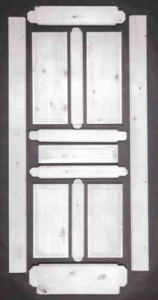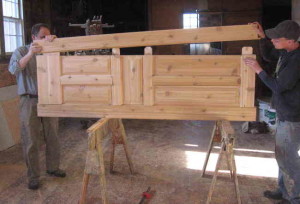Construction


Door Construction
We build our doors using true mortise and tenon construction throughout, providing superior quality and durability with three times the bonding strength of doweled door construction. More wood is used in building a door by mortise and tenon, but the results are well worth it. All surfaces are hand glued, giving you assurance of tight, trouble-free and lasting joints. Extra thick veneers at key structural points virtually eliminate the warping and twisting, sand-through and glue bleeding found in lesser doors. This assures a surface that will accept final finishes flawlessly and evenly.
All door panels are laminated to prevent splitting. Many panel options are available, from standard 1 7/16” to full door thickness
Cores:
At the heart of every door we make are our cores. Engineered in house, our cores have proven to withstand warping, bowing, twisting, and cupping better than other engineered cores and solid wood doors. This means when buying a Kampmann door you never have to worry about a door “taking off”.
The main three types of wood doors with pros and cons are as follows:
Solid core door – A door with an engineered core with no voids nor hollow spaces veneered with the desired wood.
Pros: Better insulator of heat/cold, better sound barrier, more difficult to break through than hollow doors, less likely to bow/cup/twist, has a pleasing weight and feel, will not need to be replaced as often as a hollow core door, and easy to repair.
Cons: More expensive and can be the heaviest of the three types of doors.
Solid wood door – A door which is made of ordinary wood versus engineered wood such as plywood with no voids nor hollow spaces.
Pros: Better insulator of heat/cold, better sound barrier, more difficult to break through than a hollow core door, has a pleasing weight and feel, will not need to be replaced as often as a hollow core door, and easiest to repair.
Cons: Most expensive, more apt to bow/cup/twist, heavier than a hollow core door, and shrinking could cause seams to show.
Hollow core door – A door which is void, has corrugated cardboard, or honeycombed along with an interior frame for the styles and rails, covered with a veneer or hardboard.
Pros: Significantly less expensive.
Cons: Less of a barrier for heat/cold/sound, easy to break through, and will need to be replaced more frequently.
Joints:
The backbone of any woodworking project is the joints. This is why at Kampmann Sash & Door we only use true mortise and tenon joints. This method provides all of our joints with incredible strength. We mortise our stiles with an old Northfield Foundry & Machine Co. chain mortiser.
To get a perfect fitting tenon to join with the mortise we have either our Oliver No. 125-D tenoner or our Greenlee No. 532 tenoner. A true testament to how products were made when quality was a priority over the bottom line, a testament we strongly believe in today.
Assembly:
We dry run each door to guarantee a tight fit and verify dimensions. Once verified we pull the door apart, hand glue each joint and reassemble. By hand clamping each door we are able to ensure you get the exact door you are looking for.
Contact Us
701 South 10th Street
Brainerd, MN 56401
218. 829.5621
info@kampmannmillwork.com
Copyright © 2024 · All Rights Reserved · Kampmann Sash & Door
Theme: Natural Lite by Organic Themes · RSS Feed
